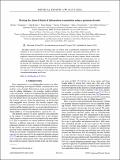| dc.contributor.author | Chapman, Robert J. | |
| dc.contributor.author | Karim, Akib | |
| dc.contributor.author | Huang, Zixin | |
| dc.contributor.author | Tomamichel, Marco | |
| dc.contributor.author | Peruzzo, Alberto | |
| dc.contributor.author | Flammia, Steven Thomas | |
| dc.date.accessioned | 2018-03-23T17:09:05Z | |
| dc.date.available | 2018-03-23T17:09:05Z | |
| dc.date.issued | 2018-01 | |
| dc.date.submitted | 2017-08 | |
| dc.identifier.issn | 2469-9926 | |
| dc.identifier.issn | 2469-9934 | |
| dc.identifier.uri | http://hdl.handle.net/1721.1/114262 | |
| dc.description.abstract | Encoding schemes and error-correcting codes are widely used in information technology to improve the reliability of data transmission over real-world communication channels. Quantum information protocols can further enhance the performance in data transmission by encoding a message in quantum states; however, most proposals to date have focused on the regime of a large number of uses of the noisy channel, which is unfeasible with current quantum technology. We experimentally demonstrate quantum enhanced communication over an amplitude damping noisy channel with only two uses of the channel per bit and a single entangling gate at the decoder. By simulating the channel using a photonic interferometric setup, we experimentally increase the reliability of transmitting a data bit by greater than 20% for a certain damping range over classically sending the message twice. We show how our methodology can be extended to larger systems by simulating the transmission of a single bit with up to eight uses of the channel and a two-bit message with three uses of the channel, predicting a quantum enhancement in all cases. | en_US |
| dc.description.sponsorship | Australian Research Council (Future Fellowship Project FT130101744) | en_US |
| dc.description.sponsorship | Australian Research Council. Centre of Excellence for Engineered Quantum Systems (Project CE110001013) | en_US |
| dc.publisher | American Physical Society | en_US |
| dc.relation.isversionof | http://dx.doi.org/10.1103/PhysRevA.97.012315 | en_US |
| dc.rights | Article is made available in accordance with the publisher's policy and may be subject to US copyright law. Please refer to the publisher's site for terms of use. | en_US |
| dc.source | American Physical Society | en_US |
| dc.title | Beating the classical limits of information transmission using a quantum decoder | en_US |
| dc.type | Article | en_US |
| dc.identifier.citation | Chapman, Robert J., et al. “Beating the Classical Limits of Information Transmission Using a Quantum Decoder.” Physical Review A, vol. 97, no. 1, Jan. 2018. © 2018 American Physical Society | en_US |
| dc.contributor.department | Massachusetts Institute of Technology. Center for Theoretical Physics | en_US |
| dc.contributor.department | Massachusetts Institute of Technology. Laboratory for Nuclear Science | en_US |
| dc.contributor.mitauthor | Flammia, Steven Thomas | |
| dc.relation.journal | Physical Review A | en_US |
| dc.eprint.version | Final published version | en_US |
| dc.type.uri | http://purl.org/eprint/type/JournalArticle | en_US |
| eprint.status | http://purl.org/eprint/status/PeerReviewed | en_US |
| dc.date.updated | 2018-02-07T20:55:28Z | |
| dc.language.rfc3066 | en | |
| dc.rights.holder | American Physical Society | |
| dspace.orderedauthors | Chapman, Robert J.; Karim, Akib; Huang, Zixin; Flammia, Steven T.; Tomamichel, Marco; Peruzzo, Alberto | en_US |
| dspace.embargo.terms | N | en_US |
| mit.license | PUBLISHER_POLICY | en_US |
